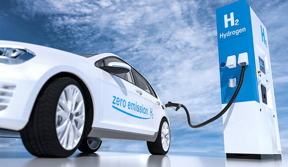Home > Press > New iron catalyst could finally! make hydrogen fuel cells affordable: Study shows the low-cost catalyst can be a viable alternative to platinum that has stymied commercialization of the eco-friendly fuel for decades because its so expensive
 |
Abstract:
For decades, scientists have been searching for a catalyst that dramatically reduces the cost of fabricating hydrogen fuel cells.
New iron catalyst could finally! make hydrogen fuel cells affordable: Study shows the low-cost catalyst can be a viable alternative to platinum that has stymied commercialization of the eco-friendly fuel for decades because its so expensive
Buffalo, NY | Posted on July 8th, 2022
Such an advancement could lead to a green power revolution, with everything from laptops to locomotives running on a fuel whose only byproduct is water.
New research led by the University at Buffalo suggests that scientists are moving closer to that goal.
In a study published Thursday (July 7) in Nature Energy, scientists describe how iron can be combined with nitrogen and carbon to produce a catalyst that is efficient, durable and inexpensive the three main objectives the U.S. Department of Energy (DOE) has identified for fuel cell research.
This has been years in the making, says the studys lead author Gang Wu, PhD, professor of chemical and biological engineering in the UB School of Engineering and Applied Sciences. We believe this is a significant breakthrough that will eventually help unleash the tremendous potential of hydrogen fuel cells.
The promise of fuel cells
Fuel cells work like batteries, but they do not run out of power or need recharging, according to DOE. They produce electricity and heat as long as fuel such as hydrogen is supplied.
They have long tantalized scientists, environmentalists and others because they have lower or zero emissions compared to combustion engines. And they can be used in a wide range of applications, providing power for vehicles, power plants, buildings and other systems.
But fuel cells are not widely commercialized because, among other things, they require expensive catalysts, which speed up important fuel cell reactions.
The best catalysts have been a family of six precious metals known as platinum-group metals. While efficient and durable, these metals are incredibly expensive because they are extremely rare. As a result, scientists are seeking less costly alternatives.
Overcoming barriers
One such alternative has been iron-based catalysts. Iron is appealing because it is abundant and inexpensive. But it does not perform as well as platinum, especially because it lacks the durability to withstand the highly corrosive and oxidative environments inside fuel cells.
To overcome this barrier, the research team bonded four nitrogen atoms to the iron. Researchers then embedded the material in a few layers of graphene with accurate atomic control of local geometric and chemical structures, Wu says.
The resulting structure is a vastly improved catalyst. For example, the research team reported the catalyst:
Is believed to be the most efficient iron-based catalyst produced to date, exceeding the DOEs 2025 target for electric current density.
Achieved a durability rating that approaches platinum group catalysts.
All this, Wu says, points to the iron-based catalysts potential to make fuel cells, particularly hydrogen fuel cells, much more affordable for commercial use. Researchers are planning follow-up studies to further improve the catalyst.
In addition to UB, the collaborative research team included members from the following organizations: Argonne National Laboratory; Carnegie Mellon University; Giner Inc.; Indiana UniversityPurdue University Indianapolis; Oak Ridge National Laboratory; Oregon State University; Purdue University; and the University of Pittsburgh.
The study was supported the U.S. Department of Energy and the U.S. National Science Foundation. Wu and two co-authors have filed joint patent applications through the University at Buffalo and Giner Inc.
####
For more information, please click here
Contacts:
Charlotte Hsu
University at Buffalo
Office: 716-645-4655
Cory Nealon,
University at Buffalo
716-645-4614
Copyright © University at Buffalo
If you have a comment, please Contact us.
Issuers of news releases, not 7th Wave, Inc. or Nanotechnology Now, are solely responsible for the accuracy of the content.
News and information
![]()
Electrically driven single microwire-based single-mode microlaser July 8th, 2022
![]()
Deep-ultraviolet nonlinear optical crystals: Concept development and materials discovery July 8th, 2022
![]()
Optical demonstration of quantum fault-tolerant threshold July 8th, 2022
![]()
Photoinduced large polaron transport and dynamics in organic-inorganic hybrid lead halide perovskite with terahertz probes July 8th, 2022
Possible Futures
![]()
Luisier wins SNSF Advanced Grant to develop simulation tools for nanoscale devices July 8th, 2022
Discoveries
![]()
Photoinduced large polaron transport and dynamics in organic-inorganic hybrid lead halide perovskite with terahertz probes July 8th, 2022
Announcements
![]()
Luisier wins SNSF Advanced Grant to develop simulation tools for nanoscale devices July 8th, 2022
Interviews/Book Reviews/Essays/Reports/Podcasts/Journals/White papers/Posters
![]()
Optical demonstration of quantum fault-tolerant threshold July 8th, 2022
![]()
Photoinduced large polaron transport and dynamics in organic-inorganic hybrid lead halide perovskite with terahertz probes July 8th, 2022
Energy
![]()
Key in increasing efficiency of next-generation solar cell, found in light absorption capacity! July 1st, 2022
![]()
Solving the solar energy storage problem with rechargeable batteries that can convert and store energy at once June 24th, 2022
![]()
Organic water splitters get a boost June 10th, 2022
Automotive/Transportation
![]()
OCSiAl expands its graphene nanotube production capacities to Europe June 17th, 2022
![]()
A sunlight-driven self-healing anti-corrosion coating May 27th, 2022
![]()
Scavenger nanoparticles could make fuel cell-powered vehicles a reality April 1st, 2022
![]()
Graphene gets enhanced by flashing: Rice process customizes one-, two- or three-element doping for applications March 31st, 2022
Fuel Cells
![]()
Scavenger nanoparticles could make fuel cell-powered vehicles a reality April 1st, 2022
![]()
Graphene gets enhanced by flashing: Rice process customizes one-, two- or three-element doping for applications March 31st, 2022
![]()
Activating lattice oxygen in perovskite oxide to optimize fuel cell performance December 17th, 2021










